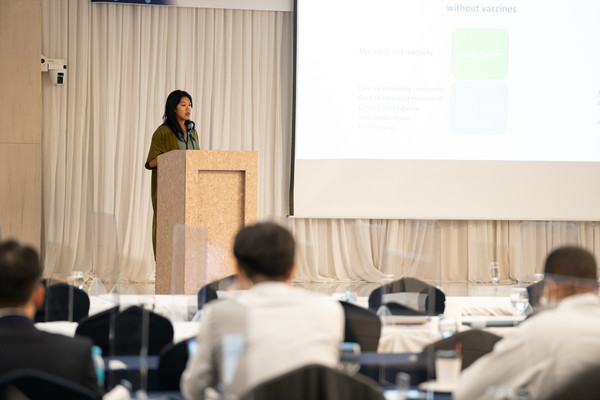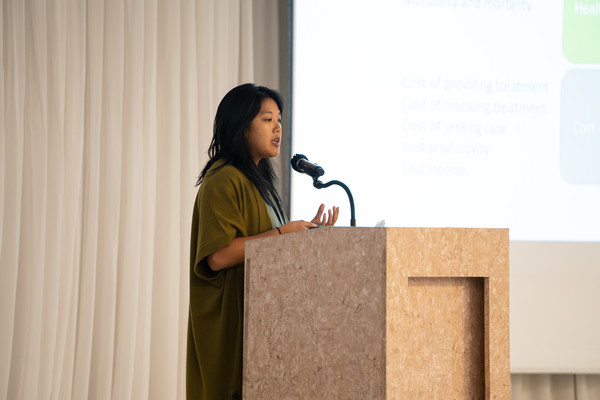Dr. Elizabeth Lee of Epidemiology at Johns Hopkins University expressed her passion for the impact of vaccines that could save people’s lives after giving a lecture on using real-world data to access the impact of vaccines during the International Vaccine Institute’s 21st vaccinology course this week.
"I'm really motivated by the impact vaccines can have on saving people's lives," Lee said.
Some of these examples include evaluating the Covid-19 vaccine effectiveness against the Omicron variant, estimating the health impact of vaccination against pathogens in low- and middle-income countries (LMICs) and optimizing the impact for delivering seasonal influenza vaccines.

After her lecture, Korea Biomedical Review spoke privately with Dr. Lee regarding her journey in infectious disease modelling and the vaccine impact of her research collaborations.
She also identified some challenges in the field of vaccine modelling and presented her perspective on a hypothetical application of using modelling to potentially accelerate clinical trials. The interview excerpts have been edited for clarity and brevity.

Question: Can you begin by giving our readers a quick insight into your research and share a little bit about your background in modelling infectious diseases?
Answer: My name is Elizabeth Lee and I'm a faculty member in the Department of Epidemiology at Johns Hopkins University’s (JHU) School of Public Health. My background is in infectious diseases epidemiology and disease dynamics. My research at Johns Hopkins has focused on cholera and Covid-19 using scenario type projections to understand what we might expect to happen if we follow different interventions. For example, regarding the Covid-19 pandemic, we first investigated non-pharmaceutical interventions and how that might change the course of the pandemic and epidemic curves respectively considering the number of hospitalizations and deaths. After vaccines were introduced, we incorporated the vaccine effectiveness into our models to understand the potential impact of these changes.
I have also done similar work for cholera focused on cholera prioritisation because it has a very limited global supply as it is not a very profitable market. Thankfully, this is changing and there is a push to incorporate these vaccines more preventatively instead of just reactively for emergency use.
Q: What motivated you to start studying in this field? Can you walk me through your journey towards your current position as a Research Associate at Johns Hokpins?
A: In my bachelors, I studied Biology and French but my interest has mostly been in translation of science to policy. After finishing my bachelors, I worked at an organisation that did science policy research which garnered my interest in quantitative analyses and modelling, so I decided to focus more on ways to translate modelling and statistical analyses into policy making.
That’s why I decided to go back to get my Ph.D at Georgetown University in global infectious diseases where I did infectious disease epidemiology concerning risk factors that lead to disease like climatic variables, human behaviour and access to care. During my Ph.D, I focused on mapping the burden of influenza illness in the U.S. and subsequently attended Johns Hopkins for my post-doctoral fellowship where I continued as a faculty member now working on cholera mapping and disease burden.
Application has always driven my choice in projects regarding how a study can be designed to help inform policy makers. Most of my work is in conjunction with Ministries of Health or WHO to provide them with evidence for writing guidance documents.
Q: Do you have recommendations for anyone interested in pursuing a career in this field?
A: I see modelling as a tool, but I think its fundamental to obtain a really good foundation in epidemiology alongside basic mathematics, statistics and coding skills to fully understand the mechanics of how the model works. I also think that the same principles apply to any kind of science discipline. For example, to understand the strengths and limitations of each approach, you need to read related papers in the field to understand how people answer questions using models.

Q: What is the impact of your current research and what do you hope to accomplish?
A: Some of the vaccine impact modelling work done for cholera has been used to motivate investments in cholera vaccines. Some of the work has been designed in conjunction with Gavi (the vaccine alliance) which is now funding cholera vaccines for eligible countries. Also, my research has been used to conduct surveillance investments in cholera to have better targeting of vaccines which will lead to better vaccine impact with the end goal of less preventable morbidities.
Q: I’m curious about what brought you to Korea for this course? Does JHU have any official collaborations with IVI? If not, what do you think would be a fruitful collaboration?
A: I was curious about IVI’s vaccinology course so I offered to give a lecture if needed. I’m aware of their work and some of the vaccine impact modelling I do is in parallel with work that IVI does.
Like IVI, JHU is officially part of the vaccine impact modelling consortium (VIMC). We receive funding to do modelling work independently, but we are not currently working with IVI. However, we are having discussion regarding future collaborations. For example, I think that work related to investigating outcomes if a cholera conjugate vaccine was widely available and comparing it to current vaccines, could be a worthwhile endeavour.
Q: What made you specifically choose to pursue health-related modelling and not another industry?
A: When I was working in science policy, it was around the time of the 2009 H1N1 pandemic and I was working at an organisation that held a conference where Dr. Fauci spoke about pandemic preparedness and he mentioned that there was a shortage of public health workers. From that moment, it piqued my interest and I eventually landed on epidemiology. I’m really motivated by the impact it can have on people’s lives and its usefulness and practical aspects.
Q: What is one of the biggest challenges in modelling that you face and how do you mitigate them?
A: I think its important to keep in mind that models are simplified versions of real-world processes so anytime you design a model it can't just be for modelling sake, it has to be to answer a specific question. You can use the same model to answer multiple questions but its important the details you choose to include in your model. For example, when I was investigating what intervention should be applied in order to change the trajectory of the Covid-19 pandemic, for broad scale interventions like lock down and masking, you just need general parameters about population transmission in population but if you really want to focus on more targeted interventions like closing schools or vaccinating only the elderly, that is where the model starts getting more complicated because you need to add more components. The complexity of the components in the model really depend on the question you are trying to answer. As a rule of thumb, its better to be as parsimonious to be sure of which factors are influencing your model results.
Q: As other lecturers presented during the course, drug development including vaccine development, is a lengthy process. Do you think modelling can be applied to help speed up some processes in clinical trials in the context of selecting a more optimal sample size?
A: It’s not really something that I’ve thought about before but based on how you describe it, I don’t think it would be possible because you really need the data generated from clinical trials to understand the response of specific populations.
However, I think it can be used in the vaccine development phase, to define preferred profiles of what the vaccine should do to achieve a certain goal. In this context, models can be designed to reduce prevalence of diseases by X amount, determine specific vaccine targets, or find vaccine candidates that can attain at least 50 percent effectiveness based on population characteristics, disease transmission data and more.
I think there might also be some examples where modelling might help you better estimate disease burden and that could be useful for the clinical trials because you need sufficient cases for trials to test your product. I believe something similar has been conducted for Ebola vaccination trials. In this instance, I could certainly see modelling being used to know that when cases might be high in a certain time and place, to optimize the roll out of the trial and increase the uptake of the product. However, due to the strict nature of protocols, it is not easy to deviate from these protocols so it might be difficult but could become possible in the future.

